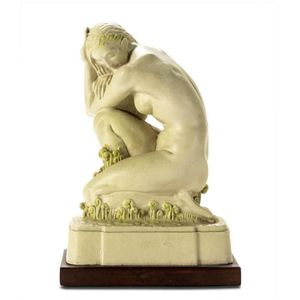Joyce Bidder's Glazed Earthenware Figure "The Croziers of Spring"
You must be a subscriber, and be logged in to view price and dealer details.
Subscribe Now to view actual auction price for this item
When you subscribe, you have the option of setting the currency in which to display prices to $Au, $US, $NZ or Stg.
- Modernism / Modernist - Modernist furniture and design emerged in the early to mid-20th century as a response to traditional styles of the 19th century and prior times, and a reflection of the technological and social changes of the time. Characteristics of Modernist furniture and design include simplicity and minimalism and clean lines and a lack of unnecessary ornamentation are key features. That form follows function is a fundamental principle of Modernist design, and furniture and objects are designed with a focus on their practical use.
Modernist furniture often incorporates geometric shapes, such as cubes, rectangles, and circles. This reflects a departure from the more ornate and curvilinear forms of previous design styles. The furniture often prioritizes ergonomic design, ensuring that objects are comfortable and user-friendly. Modernist designers aimed to create designs that could be mass-produced, making good design accessible to a broader population.
Prominent figures associated with Modernist furniture and object design include designers such as Hans Wegner, Verner Panton, Florence Knoll, Harry Bertoia and Ettore Sottsass - Earthenware - A basic ceramic material that is fired at a low temperature. Earthenware is the basis of almost all ancient, medieval, Middle Eastern and European painted ceramics. After firing, the colour is the colour of the clay when it is dug from the ground: buff, brown and red. It is not waterproof until glazed. Creamware is a type of earthenware covered with a transparent lead glaze. Majolica, faience and delft are also earthenware covered in an opaque white tin glaze.
This item has been included into following indexes:
Visually similar items

An old Chinese large carved ivory desk seal, surmounted with a shishi, scrolling mane, open back and finely detailed, standing upon the oval field with carved characters to its base. 6 x 4 x 7.5 cm

An impressive marble figure of a classical maiden braiding her hair as her robes fall from her waist, on a circular base, signed Gazzeri, Roma 1904, on a mottled green marble pedestal, marble 146 cm high, 172 cm high including pedestal

A Minton parian figural group, Naomi and her Daughters in Law, circa 1865, depicting the biblical characters of Naomi, Ruth and Oprah, titled to the front of the base, impressed Minton to base, along with a date mark, 33 cm high

Two ivory cherubs, 'The Blacksmith' and 'Caught in a Trap'. 11 cm high.
